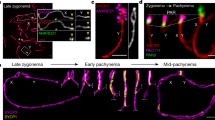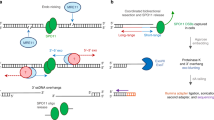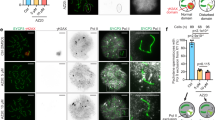Abstract
During mammalian meiosis, synapsis of paternal and maternal chromosomes and the generation of DNA breaks are needed to allow reshuffling of parental genes. In mammals errors in synapsis are associated with a male-biased meiotic impairment, which has been attributed to a response to persisting DNA double-stranded breaks in the asynapsed chromosome segments. Recently it was discovered that the chromatin of asynapsed chromosome segments is transcriptionally silenced, providing new insights into the connection between asynapsis and meiotic impairment.
This is a preview of subscription content, access via your institution
Access options
Subscribe to this journal
Receive 12 print issues and online access
$189.00 per year
only $15.75 per issue
Buy this article
- Purchase on Springer Link
- Instant access to full article PDF
Prices may be subject to local taxes which are calculated during checkout




Similar content being viewed by others
References
de Boer, P. & de Jong, J. H. in Fertility and Chromosome Pairing: Recent Studies in Plants and Animals (ed. Gillies, C. B.) 37–76 (CRC, Boca Raton, Florida, 1989).
Vincent, M. C. et al. Cytogenetic investigations of infertile men with low sperm counts: a 25-year experience. J. Androl. 23, 18–22; discussion 44–45 (2002).
Cohen, P. E., Pollack, S. E. & Pollard, J. W. Genetic analysis of chromosome pairing, recombination, and cell cycle control during first meiotic prophase in mammals. Endocr. Rev. 27, 398–426 (2006).
Hunt, P. A. & Hassold, T. J. Sex matters in meiosis. Science 296, 2181–2183 (2002).
Morelli, M. A. & Cohen, P. E. Not all germ cells are created equal: aspects of sexual dimorphism in mammalian meiosis. Reproduction 130, 761–781 (2005).
Wang, H. & Hoog, C. Structural damage to meiotic chromosomes impairs DNA recombination and checkpoint control in mammalian oocytes. J. Cell Biol. 173, 485–495 (2006).
Hassold, T. & Hunt, P. To err (meiotically) is human: the genesis of human aneuploidy. Nature Rev. Genet. 2, 280–291 (2001).
Baarends, W. M. et al. Silencing of unpaired chromatin and histone H2A ubiquitination in mammalian meiosis. Mol. Cell Biol. 25, 1041–1053 (2005).
Turner, J. M. et al. Silencing of unsynapsed meiotic chromosomes in the mouse. Nature Genet. 37, 41–47 (2005).
Turner, J. M., Mahadevaiah, S. K., Ellis, P. J., Mitchell, M. J. & Burgoyne, P. S. Pachytene asynapsis drives meiotic sex chromosome inactivation and leads to substantial postmeiotic repression in spermatids. Dev. Cell 10, 521–529 (2006).
Ferguson, K. A., Chow, V. & Ma, S. Silencing of unpaired meiotic chromosomes and altered recombination patterns in an azoospermic carrier of a t(8;13) reciprocal translocation. Hum. Reprod. 23, 988–995 (2008).
Sciurano, R., Rahn, M., Rey-Valzacchi, G. & Solari, A. J. The asynaptic chromatin in spermatocytes of translocation carriers contains the histone variant γ-H2AX and associates with the XY body. Hum. Reprod. 22, 142–50 (2007).
Hochwagen, A. & Amon, A. Checking your breaks: surveillance mechanisms of meiotic recombination. Curr. Biol. 16, R217–R228 (2006).
Roeder, G. S. & Bailis, J. M. The pachytene checkpoint. Trends Genet. 16, 395–403 (2000).
Ashley, T. in Results and Problems in Cell Differentiation Vol. 28 (ed. McElreavey, K.) 131–173 (Springer, Berlin, 2000).
de Rooij, D. G. & de Boer, P. Specific arrests of spermatogenesis in genetically modified and mutant mice. Cytogenet. Genome Res. 103, 267–276 (2003).
Burgoyne, P. S. & Baker, T. G. Perinatal oocyte loss in XO mice and its implications for the aetiology of gonadal dysgenesis in XO women. J. Reprod. Fertil. 75, 633–645 (1985).
Burgoyne, P. S., Mahadevaiah, S. K. & Mittwoch, U. A reciprocal autosomal translocation which causes male sterility in the mouse also impairs oogenesis. J. Reprod. Fertil. 75, 647–652 (1985).
Mittwoch, U., Mahadevaiah, S. K. & Setterfield, L. A. Pachytene pairing and oocyte numbers in mice with two single Robertsonian translocations and the male-sterile compound with monobrachial homology. Cytogenet. Cell Genet. 53, 144–147 (1990).
Setterfield, L. A., Mahadevaiah, S. K. & Mittwoch, U. Chromosome pairing and germ cell loss in male and female mice carrying a reciprocal translocation. J. Reprod. Fertil. 82, 369–379 (1988).
Pittman, D. L. et al. Meiotic prophase arrest with failure of chromosome synapsis in mice deficient for Dmc1, a germline-specific RecA homolog. Mol. Cell 1, 697–705 (1998).
Yoshida, K. et al. The mouse RecA-like gene Dmc1 is required for homologous chromosome synapsis during meiosis. Mol. Cell 1, 707–718 (1998).
Romanienko, P. J. & Camerini-Otero, R. D. The mouse Spo11 gene is required for meiotic chromosome synapsis. Mol. Cell 6, 975–987 (2000).
Baudat, F., Manova, K., Yuen, J. P., Jasin, M. & Keeney, S. Chromosome synapsis defects and sexually dimorphic meiotic progression in mice lacking Spo11. Mol. Cell 6, 989–998 (2000).
Edelmann, W. et al. Mammalian MutS homologue 5 is required for chromosome pairing in meiosis. Nature Genet. 21, 123–127 (1999).
Kneitz, B. et al. MutS homolog 4 localization to meiotic chromosomes is required for chromosome pairing during meiosis in male and female mice. Genes Dev. 14, 1085–1097 (2000).
de Vries, F. A. et al. Mouse Sycp1 functions in synaptonemal complex assembly, meiotic recombination, and XY body formation. Genes Dev. 19, 1376–1389 (2005).
Libby, B. J. et al. The mouse meiotic mutation mei1 disrupts chromosome synapsis with sexually dimorphic consequences for meiotic progression. Dev. Biol. 242, 174–187 (2002).
de Vries, S. S. et al. Mouse MutS-like protein MSH5 is required for proper chromosome synapsis in male and female meiosis. Genes Dev. 13, 523–531 (1999).
Deckbar, D. et al. Chromosome breakage after G2 checkpoint release. J. Cell Biol. 176, 749–755 (2007).
Marcon, E. & Moens, P. B. The evolution of meiosis: recruitment and modification of somatic DNA-repair proteins. Bioessays 27, 795–808 (2005).
Burgoyne, P. S., Mahadevaiah, S. K. & Turner, J. M. The management of DNA double-strand breaks in mitotic G2, and in mammalian meiosis viewed from a mitotic G2 perspective. Bioessays 29, 974–986 (2007).
Plug, A. W. et al. Changes in protein composition of meiotic nodules during mammalian meiosis. J. Cell Sci. 111, 413–423 (1998).
Keegan, K. S. et al. The Atr and Atm protein kinases associate with different sites along meiotically pairing chromosomes. Genes Dev. 10, 2423–2437 (1996).
Moens, P. B. et al. The association of ATR protein with mouse meiotic chromosome cores. Chromosoma 108, 95–102 (1999).
Perera, D. et al. TopBP1 and ATR colocalization at meiotic chromosomes: role of TopBP1/Cut5 in the meiotic recombination checkpoint. Mol. Biol. Cell 15, 1568–1579 (2004).
Turner, J. M. et al. BRCA1, histone H2AX phosphorylation, and male meiotic sex chromosome inactivation. Curr. Biol. 14, 2135–42 (2004).
Scully, R. et al. Association of BRCA1 with Rad51 in mitotic and meiotic cells. Cell 88, 265–275 (1997).
Mahadevaiah, S. K. et al. Recombinational DNA double-strand breaks in mice precede synapsis. Nature Genet. 27, 271–276 (2001).
Mahadevaiah, S. K. et al. Extensive meiotic asynapsis in mice antagonises meiotic silencing of unsynapsed chromatin and consequently disrupts meiotic sex chromosome inactivation. J. Cell Biol. 182, 263–276 (2008).
Barchi, M. et al. Surveillance of different recombination defects in mouse spermatocytes yields distinct responses despite elimination at an identical developmental stage. Mol. Cell Biol. 25, 7203–7215 (2005).
Hamer, G., Kal, H. B., Westphal, C. H., Ashley, T. & de Rooij, D. G. Ataxia telangiectasia mutated expression and activation in the testis. Biol. Reprod. 70, 1206–1212 (2004).
Bolcun-Filas, E. et al. SYCE2 is required for synaptonemal complex assembly, double strand break repair, and homologous recombination. J. Cell Biol. 176, 741–747 (2007).
Ashley, T., Gaeth, A. P., Creemers, L. B., Hack, A. M. & de Rooij, D. G. Correlation of meiotic events in testis sections and microspreads of mouse spermatocytes relative to the mid-pachytene checkpoint. Chromosoma 113, 126–136 (2004).
O'Doherty, A. et al. An aneuploid mouse strain carrying human chromosome 21 with Down syndrome phenotypes. Science 309, 2033–2037 (2005).
Habermann, B. et al. DAZ (Deleted in AZoospermia) genes encode proteins located in human late spermatids and sperm tails. Hum. Reprod. 13, 363–369 (1998).
Turner, J. M. A. & Burgoyne, P. S. in The Y Chromosome and Male Germ Cell Biology in Health and Diseases (eds Lau, Y.-F. C. & Chan, W. Y.) 27–46 (World Scientific, Hackensack, New Jersey, 2006).
Handel, M. A. The XY body: a specialized meiotic chromatin domain. Exp. Cell Res. 296, 57–63 (2004).
Khil, P. P., Smirnova, N. A., Romanienko, P. J. & Camerini-Otero, R. D. The mouse X chromosome is enriched for sex-biased genes not subject to selection by meiotic sex chromosome inactivation. Nature Genet. 36, 642–646 (2004).
Monesi, V. Synthetic activities during spermatogenesis in the mouse. Exp. Cell Res. 39, 197–224 (1965).
Moore, G. P. DNA-dependent RNA synthesis in fixed cells during spermatogenesis in mouse. Exp. Cell Res. 68, 462–465 (1971).
Namekawa, S. H. et al. Postmeiotic sex chromatin in the male germline of mice. Curr. Biol. 16, 660–667 (2006).
Turner, J. M. Meiotic sex chromosome inactivation. Development 134, 1823–1831 (2007).
Solari, A. J. The behaviour of the XY pair in mammals. Int. Rev. Cytol. 38, 273–317 (1974).
Fernandez-Capetillo, O. et al. H2AX is required for chromatin remodeling and inactivation of sex chromosomes in male mouse meiosis. Dev. Cell 4, 497–508 (2003).
Xu, X., Aprelikova, O., Moens, P., Deng, C. X. & Furth, P. A. Impaired meiotic DNA-damage repair and lack of crossing-over during spermatogenesis in BRCA1 full-length isoform deficient mice. Development 130, 2001–2012 (2003).
Bellani, M. A., Romanienko, P. J., Cairatti, D. A. & Camerini-Otero, R. D. SPO11 is required for sex-body formation, and Spo11 heterozygosity rescues the prophase arrest of Atm−/− spermatocytes. J. Cell Sci. 118, 3233–3245 (2005).
Bourc'his, D. & Bestor, T. H. Meiotic catastrophe and retrotransposon reactivation in male germ cells lacking Dnmt3L. Nature 431, 96–9 (2004).
Homolka, D., Ivanek, R., Capkova, J., Jansa, P. & Forejt, J. Chromosomal rearrangement interferes with meiotic X chromosome inactivation. Genome Res. 17, 1431–1437 (2007).
Kolas, N. K. et al. Mutant meiotic chromosome core components in mice can cause apparent sexual dimorphic endpoints at prophase or X-Y defective male-specific sterility. Chromosoma 114, 92–102 (2005).
Li, X. C. & Schimenti, J. C. Mouse pachytene checkpoint 2 (trip13) is required for completing meiotic recombination but not synapsis. PLoS Genet. 3, e130 (2007).
Schimenti, J. Synapsis or silence. Nature Genet. 37, 11–13 (2005).
Shiu, P. K., Raju, N. B., Zickler, D. & Metzenberg, R. L. Meiotic silencing by unpaired DNA. Cell 107, 905–916 (2001).
Schoenmakers, S. et al. Increased frequency of asynapsis and associated meiotic silencing of heterologous chromatin in the presence of irradiation-induced extra DNA double strand breaks. Dev. Biol. 317, 270–281 (2008).
Oakberg, E. F. Duration of spermatogenesis in the mouse and timing of stages of the cycle of the seminiferous epithelium. Am. J. Anat. 99, 507–516 (1956).
Wang, P. J. X chromosomes, retrogenes and their role in male reproduction. Trends Endocrinol. Metab. 15, 79–83 (2004).
Rohozinski, J. & Bishop, C. E. The mouse juvenile spermatogonial depletion (jsd) phenotype is due to a mutation in the X-derived retrogene, mUtp14b. Proc. Natl Acad. Sci. USA 101, 11695–11700 (2004).
Bradley, J. et al. An X-to-autosome retrogene is required for spermatogenesis in mice. Nature Genet. 36, 872–876 (2004).
Zhao, M. et al. Utp14b: a unique retrogene within a gene that has acquired multiple promoters and a specific function in spermatogenesis. Dev. Biol. 304, 848–859 (2007).
Khalil, A. M., Boyar, F. Z. & Driscoll, D. J. Dynamic histone modifications mark sex chromosome inactivation and reactivation during mammalian spermatogenesis. Proc. Natl Acad. Sci. USA 101, 16583–16587 (2004).
van der Heijden, G. W. et al. Chromosome-wide nucleosome replacement and H3.3 incorporation during mammalian meiotic sex chromosome inactivation. Nature Genet. 39, 251–258 (2007).
Greaves, I. K., Rangasamy, D., Devoy, M., Marshall Graves, J. A. & Tremethick, D. J. The X and Y chromosomes assemble into H2A.Z, containing facultative heterochromatin, following meiosis. Mol. Cell Biol. 26, 5394–405 (2006).
Mueller, J. L. et al. The mouse X chromosome is enriched for multicopy testis genes showing postmeiotic expression. Nature Genet. 40, 794–799 (2008).
Peters, A. H., Plug, A. W. & de Boer, P. Meiosis in carriers of heteromorphic bivalents: sex differences and implications for male fertility. Chromosome Res. 5, 313–324 (1997).
van der Laan, R. et al. Ubiquitin ligase Rad18Sc localizes to the XY body and to other chromosomal regions that are unpaired and transcriptionally silenced during male meiotic prophase. J. Cell Sci. 117, 5023–33 (2004).
Di Giacomo, M. et al. Distinct DNA-damage-dependent and -independent responses drive the loss of oocytes in recombination-defective mouse mutants. Proc. Natl Acad. Sci. USA 102, 737–742 (2005).
Sugimoto, M. & Abe, K. X chromosome reactivation initiates in nascent primordial germ cells in mice. PLoS Genet. 3, e116 (2007).
Chuva de Sousa Lopes, S. M. et al. X chromosome activity in mouse XX primordial germ cells. PLoS Genet. 4, e30 (2008).
de Napoles, M., Nesterova, T. & Brockdorff, N. Early loss of Xist RNA expression and inactive X chromosome associated chromatin modification in developing primordial germ cells. PLoS ONE 2, e860 (2007).
Speed, R. M. Oocyte development in XO foetuses of man and mouse: the possible role of heterologous X-chromosome pairing in germ cell survival. Chromosoma 94, 115–124 (1986).
Celeste, A. et al. Histone H2AX phosphorylation is dispensable for the initial recognition of DNA breaks. Nature Cell Biol. 5, 675–679 (2003).
Wang, W. H. & Sun, Q. Y. Meiotic spindle, spindle checkpoint and embryonic aneuploidy. Front. Biosci. 11, 620–636 (2006).
Petronczki, M., Siomos, M. F. & Nasmyth, K. Un menage a quatre: the molecular biology of chromosome segregation in meiosis. Cell 112, 423–440 (2003).
Yamamoto, A. et al. Spindle checkpoint activation at meiosis I advances anaphase II onset via meiosis-specific APC/C regulation. J. Cell Biol. 182, 277–288 (2008).
Ashley, T., Ried, T. & Ward, D. C. Detection of nondisjunction and recombination in meiotic and postmeiotic cells from XYSxr [XY, Tp(Y)1Ct] mice using multicolor fluorescence in situ hybridization. Proc. Natl Acad. Sci. USA 91, 524–528 (1994).
Burgoyne, P. S., Mahadevaiah, S. K., Sutcliffe, M. J. & Palmer, S. J. Fertility in mice requires X-Y pairing and a Y-chromosomal 'spermiogenesis' gene mapping to the long arm. Cell 71, 391–398 (1992).
Evans, E. P., Burtenshaw, M. D. & Cattanach, B. M. Meiotic crossing over between the X and Y chromosomes of male mice carrying the sex-reversing (Sxr) factor. Nature 300, 443–445 (1982).
Odorisio, T., Rodriguez, T. A., Evans, E. P., Clarke, A. R. & Burgoyne, P. S. The meiotic checkpoint monitoring synapsis eliminates spermatocytes via p53-independent apoptosis. Nature Genet. 18, 257–261 (1998).
Eaker, S., Pyle, A., Cobb, J. & Handel, M. A. Evidence for meiotic spindle checkpoint from analysis of spermatocytes from Robertsonian-chromosome heterozygous mice. J. Cell Sci. 114, 2953–2965 (2001).
Vogt, E., Kirsch-Volders, M., Parry, J. & Eichenlaub-Ritter, U. Spindle formation, chromosome segregation and the spindle checkpoint in mammalian oocytes and susceptibility to meiotic error. Mutat. Res. 651, 14–29 (2008).
Hunt, P., LeMaire, R., Embury, P., Sheean, L. & Mroz, K. Analysis of chromosome behaviour in intact mammalian oocytes: monitoring the segregation of a univalent chromosome during female meiosis. Hum. Mol. Genet. 4, 2007–2012 (1995).
LeMaire-Adkins, R., Radke, K. & Hunt, P. A. Lack of checkpoint control at the metaphase/anaphase transition: a mechanism of meiotic nondisjunction in mammalian females. J. Cell Biol. 139, 1611–1619 (1997).
Hodges, C. A., LeMaire-Adkins, R. & Hunt, P. A. Coordinating the segregation of sister chromatids during the first meiotic division: evidence for sexual dimorphism. J. Cell Sci. 114, 2417–2426 (2001).
Hodges, C. A., Revenkova, E., Jessberger, R., Hassold, T. J. & Hunt, P. A. SMC1β-deficient female mice provide evidence that cohesins are a missing link in age-related nondisjunction. Nature Genet. 37, 1351–1355 (2005).
Hunt, P. A. & Hassold, T. J. Human female meiosis: what makes a good egg go bad? Trends Genet. 24, 86–93 (2008).
Jones, K. T. Meiosis in oocytes: predisposition to aneuploidy and its increased incidence with age. Hum. Reprod. Update 14, 143–158 (2008).
Kouznetsova, A., Lister, L., Nordenskjold, M., Herbert, M. & Hoog, C. Bi-orientation of achiasmatic chromosomes in meiosis I oocytes contributes to aneuploidy in mice. Nature Genet. 39, 966–968 (2007).
Lyon, M. F. & Hawker, S. G. Reproductive lifespan in irradiated and unirradiated chromosomally XO mice. Genet. Res. 21, 185–194 (1973).
Woods, L. M. et al. Chromosomal influence on meiotic spindle assembly: abnormal meiosis I in female Mlh1 mutant mice. J. Cell Biol. 145, 1395–1406 (1999).
Zickler, D. & Kleckner, N. Meiotic chromosomes: integrating structure and function. Annu. Rev. Genet. 33, 603–754 (1999).
Moses, M. J. & Poorman, P. A. in Chromosomes Today Vol. 8 (eds Bennet, M. D., Gropp, A. & Wolf, U.) 80–103 (Allen and Unwin, London, 1984).
Baudat, F., Manova, K., Yuen, J. P., Jasin, M. & Keeney, S. Chromosome synapsis defects and sexually dimorphic meiotic progression in mice lacking Spo11. Cell 6, 989–998 (2000).
Wang, X. & Haber, J. E. Role of Saccharomyces single-stranded DNA-binding protein RPA in the strand invasion step of double-strand break repair. PLoS Biol. 2, E21 (2004).
Author information
Authors and Affiliations
Corresponding author
Related links
Related links
DATABASES
OMIM
FURTHER INFORMATION
Rights and permissions
About this article
Cite this article
Burgoyne, P., Mahadevaiah, S. & Turner, J. The consequences of asynapsis for mammalian meiosis. Nat Rev Genet 10, 207–216 (2009). https://doi.org/10.1038/nrg2505
Issue Date:
DOI: https://doi.org/10.1038/nrg2505
This article is cited by
-
Seeding the meiotic DNA break machinery and initiating recombination on chromosome axes
Nature Communications (2024)
-
Temperature sensitivity of DNA double-strand break repair underpins heat-induced meiotic failure in mouse spermatogenesis
Communications Biology (2022)
-
Active DNA damage response signaling initiates and maintains meiotic sex chromosome inactivation
Nature Communications (2022)
-
Meiotic sex chromosome inactivation and the XY body: a phase separation hypothesis
Cellular and Molecular Life Sciences (2022)
-
Meiosis-specific ZFP541 repressor complex promotes developmental progression of meiotic prophase towards completion during mouse spermatogenesis
Nature Communications (2021)



